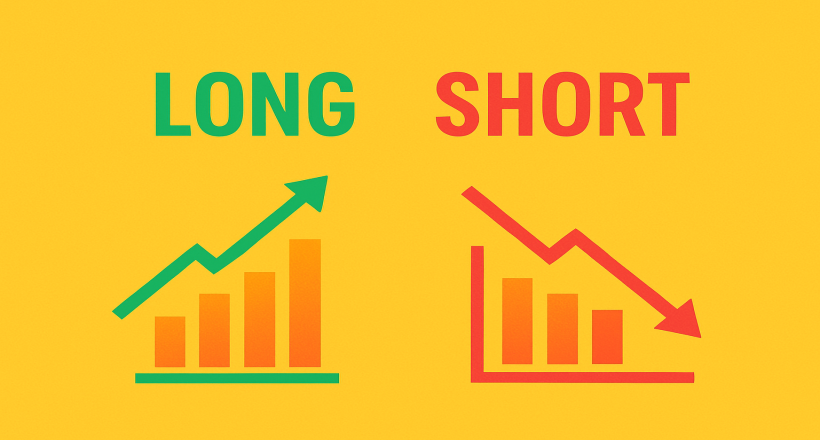
The cryptocurrency market, due to its high volatility, provides traders with numerous opportunities to make profits. In this market, investors can benefit not only from rising asset prices but also from falling ones. To achieve such profits, it is essential to understand trading tools and strategies and to be familiar with specialized market concepts. One of the most important of these concepts is Long and Short positions.
Long and Short trades allow traders to take on a certain level of risk with their assets and profit if their market predictions turn out correct. When a trader accurately anticipates price movements, the potential for significant returns exists. In this article, we will explain what Long and Short positions are, how they differ from one another, and under what conditions each can be applied in trading.
Types of Trading Positions in Financial Markets
Whenever you enter a trade in financial markets, you are essentially taking a position that exposes you to price fluctuations. Generally, trading positions are divided into two main categories: Long Position and Short Position. These two concepts were first introduced by traders on the New York Stock Exchange and are now widely used in all types of trading, from spot trading to futures contracts. Let’s take a closer look at each of them.
What Is a Long Position?
A Long position refers to buying an asset with the expectation that its price will rise in the future so it can later be sold at a higher value. Traders adopt this strategy when they anticipate a bullish trend in the market. In simple terms, going long means buying low and selling high. In bullish markets, the number of Long trades is typically higher than Short trades.
Advantages of Long Positions:
Disadvantages of Long Positions:
What Is a Short Position?
A Short position is somewhat more complex than a Long. In this case, a trader who expects the market to decline borrows an asset from an exchange or broker and sells it immediately at the current market price. Later, when the asset’s price drops, the trader buys back the same amount at the lower price and returns it to the exchange. The profit comes from the difference between the initial selling price and the repurchase price. This practice is also known as short selling. In essence, shorting means selling high and buying back low. In bearish markets, the number of Short trades generally increases.
Advantages of Short Positions:
Disadvantages of Short Positions:
Using Leverage in Long and Short Trades
In markets such as Forex and cryptocurrencies, many traders use leverage trading to increase their potential profits. Leverage essentially allows them to enter a trade with an amount greater than their actual capital, borrowing the remaining funds from an exchange or broker. The higher the leverage, the greater both profits and losses will be. For this reason, leverage is inherently high-risk but is widely used in the crypto market.
To open a leveraged position, the trader must deposit a portion of the total trade value as collateral or margin with the exchange. This margin acts as a guarantee that the trader will fulfill their obligations. After that, the exchange provides the rest of the required funds to enter the trade. To better understand how this works, let’s look at two examples:
Example of a Leveraged Long Position
Suppose the price of Bitcoin (BTC) is $100,000, and a trader predicts that within the next 24 hours, the price will rise to $110,000. The trader decides to open a Long position with 100× leverage. In this case, they only need to deposit 1/100 of the total trade value—$1,000—as margin, while the exchange provides the rest. If the price increases as predicted, the trader will earn a profit of $10,000.
Example of a Leveraged Short Position
Now imagine Ethereum (ETH) is trading at $4,000, and the trader expects the price to drop to $3,600 within a day. They decide to open a Short position with 50× leverage on 25 ETH. For this trade, only $2,000 (1/50 of the total trade value) needs to be deposited as collateral. If the prediction is correct and the price falls, the trader’s profit will amount to $10,000.
When Should You Use Long and Short Positions?
Both types of trading positions play an important role in financial markets, allowing investors to profit in both bullish and bearish conditions. Although Long and Short are opposite concepts, a trader is not limited to using only one. In many cases, traders open both types of positions simultaneously or at different times to apply strategies such as hedging.
When entering Long or Short trades, identifying key support and resistance levels is crucial. Given the high volatility in the crypto market—especially when using leverage—the risk of losing capital or getting liquidated is significant. Therefore, before opening any position, traders should consider various forms of analysis, including technical analysis, market sentiment, fundamental analysis, and even on-chain data. Trend charts also provide valuable insights into when entering a Long or Short position may be more logical.
Conclusion
In all financial markets, some traders profit from rising prices, while others gain from falling asset values. The cryptocurrency market, due to its volatility, offers countless opportunities for profit. Among the most important tools to capitalize on price movements are Long and Short trades. Those optimistic about the future of a cryptocurrency and expecting its growth usually open Long positions, while traders anticipating a decline in price prefer Short positions.